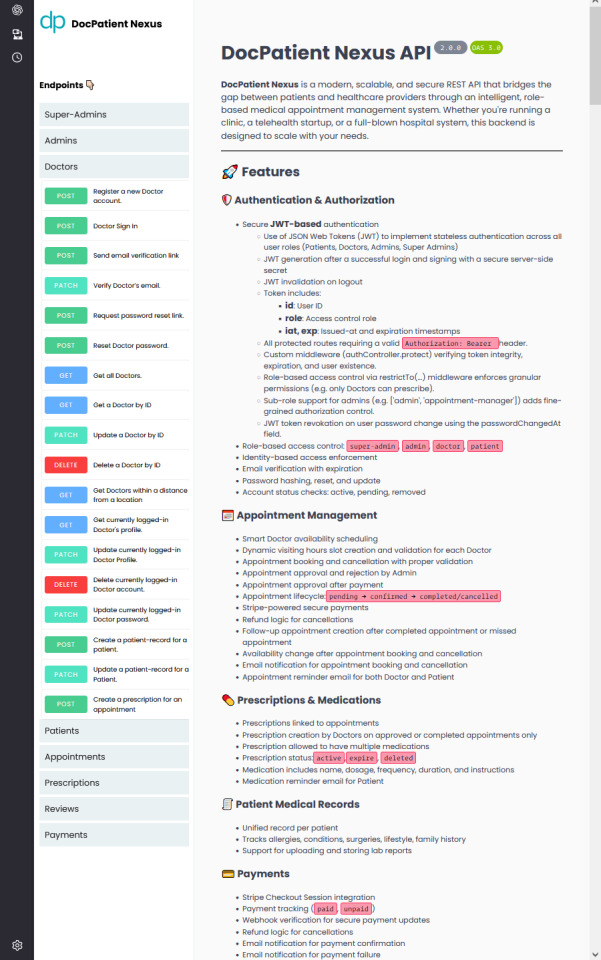#REST API
Explore tagged Tumblr posts
Text
SQL Injection in RESTful APIs: Identify and Prevent Vulnerabilities
SQL Injection (SQLi) in RESTful APIs: What You Need to Know
RESTful APIs are crucial for modern applications, enabling seamless communication between systems. However, this convenience comes with risks, one of the most common being SQL Injection (SQLi). In this blog, we’ll explore what SQLi is, its impact on APIs, and how to prevent it, complete with a practical coding example to bolster your understanding.

What Is SQL Injection?
SQL Injection is a cyberattack where an attacker injects malicious SQL statements into input fields, exploiting vulnerabilities in an application's database query execution. When it comes to RESTful APIs, SQLi typically targets endpoints that interact with databases.
How Does SQL Injection Affect RESTful APIs?
RESTful APIs are often exposed to public networks, making them prime targets. Attackers exploit insecure endpoints to:
Access or manipulate sensitive data.
Delete or corrupt databases.
Bypass authentication mechanisms.
Example of a Vulnerable API Endpoint
Consider an API endpoint for retrieving user details based on their ID:
from flask import Flask, request import sqlite3
app = Flask(name)
@app.route('/user', methods=['GET']) def get_user(): user_id = request.args.get('id') conn = sqlite3.connect('database.db') cursor = conn.cursor() query = f"SELECT * FROM users WHERE id = {user_id}" # Vulnerable to SQLi cursor.execute(query) result = cursor.fetchone() return {'user': result}, 200
if name == 'main': app.run(debug=True)
Here, the endpoint directly embeds user input (user_id) into the SQL query without validation, making it vulnerable to SQL Injection.
Secure API Endpoint Against SQLi
To prevent SQLi, always use parameterized queries:
@app.route('/user', methods=['GET']) def get_user(): user_id = request.args.get('id') conn = sqlite3.connect('database.db') cursor = conn.cursor() query = "SELECT * FROM users WHERE id = ?" cursor.execute(query, (user_id,)) result = cursor.fetchone() return {'user': result}, 200
In this approach, the user input is sanitized, eliminating the risk of malicious SQL execution.
How Our Free Tool Can Help
Our free Website Security Checker your web application for vulnerabilities, including SQL Injection risks. Below is a screenshot of the tool's homepage:
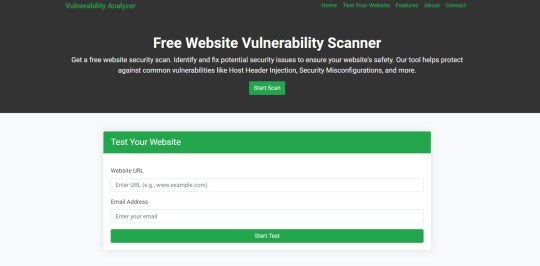
Upload your website details to receive a comprehensive vulnerability assessment report, as shown below:
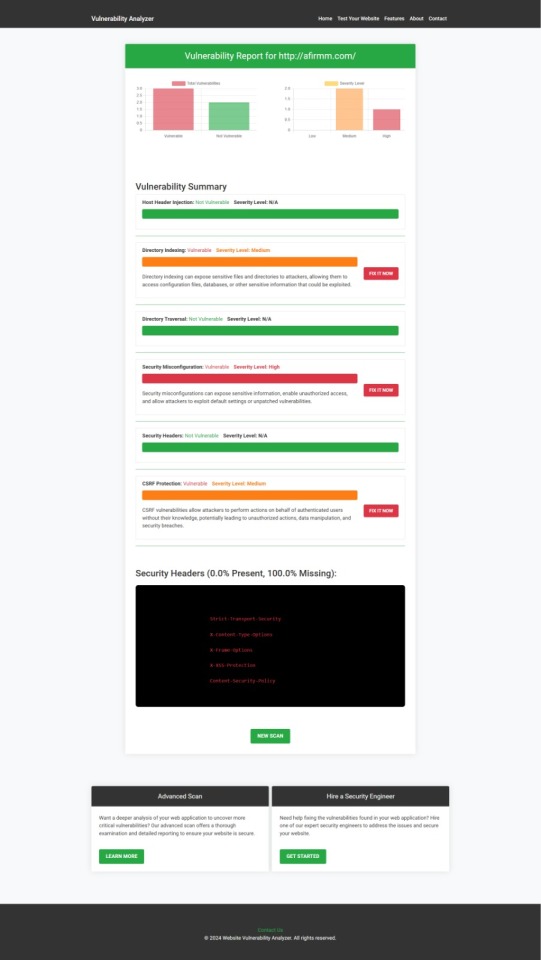
These tools help identify potential weaknesses in your APIs and provide actionable insights to secure your system.
Preventing SQLi in RESTful APIs
Here are some tips to secure your APIs:
Use Prepared Statements: Always parameterize your queries.
Implement Input Validation: Sanitize and validate user input.
Regularly Test Your APIs: Use tools like ours to detect vulnerabilities.
Least Privilege Principle: Restrict database permissions to minimize potential damage.
Final Thoughts
SQL Injection is a pervasive threat, especially in RESTful APIs. By understanding the vulnerabilities and implementing best practices, you can significantly reduce the risks. Leverage tools like our free Website Security Checker to stay ahead of potential threats and secure your systems effectively.
Explore our tool now for a quick Website Security Check.
#cyber security#cybersecurity#data security#pentesting#security#sql#the security breach show#sqlserver#rest api
2 notes
·
View notes
Text
Call my fist an HTTP Post request, the way it delivers a message of pain directly to the endpoint of your face.
2 notes
·
View notes
Text
What Is API Integration? A Beginner’s Guide for Businesses
In today’s fast-paced digital landscape, businesses must adopt smarter ways to connect systems, automate workflows, and improve efficiency. One of the most powerful tools driving this evolution is API integration. But what exactly is an API, and how does it benefit your business?
This guide breaks down the fundamentals of API integration in simple, non-technical terms — perfect for entrepreneurs, business owners, product managers, and startup teams. Learn how APIs (Application Programming Interfaces) enable different software applications to communicate and exchange data seamlessly. Discover how API integration can help you streamline operations, reduce manual work, improve customer experience, and enable real-time data flow across platforms like CRMs, ERPs, payment gateways, and more.
We also explore key use cases, industries benefiting from APIs, and practical insights into selecting the right integration strategies for your business. Whether you're running an e-commerce platform, managing enterprise systems, or building a SaaS product, understanding API integration is no longer optional — it’s essential.
By the end of this article, you'll have a solid foundation on what API integration is, why it matters, and how it can be a game-changer for your growth and scalability.
#API Integration#What is API#Business Automation#Digital Transformation#REST API#Web Services#Software Integration#API for Business#Cloud Integration#Business Technology#Enterprise APIs#SaaS Integration#API Examples#API Integration Guide#System Integration
0 notes
Text
Need REST: Apps working with IoT data
0 notes
Text
Introduction to REST API in Python
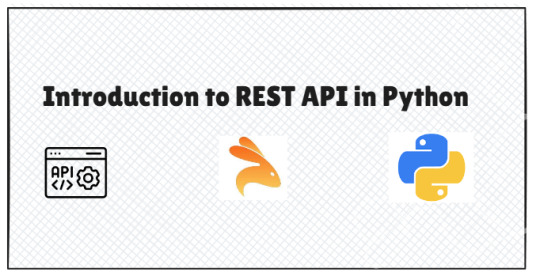
APIs (Application Programming Interfaces) are like bridges that let different software systems talk to each other. Among the many types of APIs, REST APIs are the most popular because they follow a simple and well-defined architecture. In this blog, we’ll explore what REST APIs are, how they work in Python, and how you can build and test them easily.
What is a REST API?
A REST API (Representational State Transfer Application Programming Interface) is a set of rules that allows programs to communicate over the web. It uses standard HTTP methods like GET, POST, PUT, and DELETE to perform operations on resources, which are identified by URLs.
For instance, a REST API for a bookstore might have endpoints like:
GET /books – Retrieve a list of books
POST /books – Add a new book
GET /books/{id} – Retrieve a specific book
PUT /books/{id} – Update a specific book
DELETE /books/{id} – Delete a specific book
REST APIs are stateless, meaning each request from a client contains all the information needed to process the request, without relying on stored context on the server.
What is a Python REST API Framework?
A Python REST API framework is a collection of libraries and tools that simplify the process of building RESTful APIs in Python. These frameworks handle the routing of HTTP requests, serialization of data, and other common tasks, allowing developers to focus on the core functionality of their applications.
Popular Python REST API frameworks include:
Flask: A lightweight and flexible micro-framework suitable for small to medium applications.
FastAPI: A modern, high-performance framework designed for building APIs with Python 3.7+ using type hints.
Django REST Framework (DRF): A powerful and feature-rich framework built on top of Django, ideal for large-scale applications.
Understanding the Capabilities of REST API and REST Principles
REST APIs adhere to six guiding principles:
Statelessness: Each request from the client must contain all the information needed by the server to process the request.
Client-Server Architecture: The client and server operate independently, allowing for separation of concerns.
Cacheability: Responses must define themselves as cacheable or not to prevent clients from reusing stale or inappropriate data.
Uniform Interface: A consistent and standardized interface simplifies interactions between components.
Layered System: The architecture can be composed of hierarchical layers by constraining component behavior.
Code on Demand (optional): Servers can extend client functionality by transferring executable code.
Understanding these principles helps in designing scalable and maintainable APIs.
Benefits of REST API
The benefits of REST API are vast and implementing them offers several advantages:
Scalability: Statelessness allows servers to handle more requests by distributing the load.
Flexibility: Clients and servers can evolve independently as long as the interface between them is not altered.
Simplicity: Using standard HTTP methods makes it easy to understand and use.
Performance: Caching mechanisms can improve performance by reducing the need for repeated processing.
Modularity: Encourages separation of concerns, making it easier to manage and update components.
Types of Python Frameworks
Python offers various frameworks for building REST APIs, each catering to different needs:
a. Microframeworks
Flask: Minimalistic and easy to get started with, ideal for small applications and prototyping.
Falcon: Focuses on high performance and reliability, suitable for large-scale applications.
b. Full-Stack Frameworks
Django: Comes with a plethora of built-in features like ORM, authentication, and admin interface, suitable for complex applications.
c. Asynchronous Frameworks
FastAPI: Leverages Python's async capabilities for high-performance APIs, with automatic documentation generation.
What Should You Consider When Choosing a Python REST API Framework?
Selecting the right framework depends on various factors:
Project Size: For small projects, Flask or FastAPI might suffice; for larger projects, Django could be more appropriate.
Performance Needs: FastAPI offers superior performance due to its asynchronous nature.
Learning Curve: Flask has a gentle learning curve, while Django and FastAPI might require more time to master.
Community and Support: Django has a large community and extensive documentation, which can be beneficial for troubleshooting and learning.
Python REST API Frameworks You Should Know
Here's a comparison of popular Python REST API frameworks:FrameworkTypeKey FeaturesFlaskMicroframeworkSimple, flexible, extensive extensionsFastAPIAsynchronousHigh performance, automatic docs, type hintsDjangoFull-StackBuilt-in ORM, admin interface, authenticationFalconMicroframeworkHigh performance, minimalistic, reliable
Building a Simple REST API with Python
Let's build a simple REST API using Flask that manages a list of users.
a. Setup
Install Flask:CopyCopypip install Flask
b. Code Example
CopyCopyfrom flask import Flask, jsonify, request app = Flask(__name__) users = [] @app.route('/') def home(): return jsonify({ "message": "Welcome to the User API!", "routes": { "GET /users": "Get all users", "POST /users": "Create a new user" } }) @app.route('/users', methods=['GET']) def get_users(): return jsonify(users) @app.route('/users', methods=['POST']) def create_user(): user = request.get_json() users.append(user) return jsonify(user), 201 if __name__ == '__main__': app.run(debug=True)
c. Testing the API
GET /users: Returns the list of users.
POST /users: Adds a new user to the list.
Run the application in a dedicated terminal and navigate to this IP- 127.0.0.1:5000.You can test the API using tools like Postman or cURL.
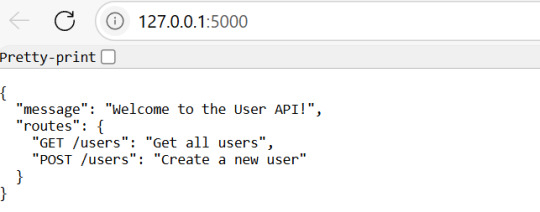
How to Test Your REST APIs Without Writing Code?
Unit testing agent
Keploy has recently released a Unit Testing Agent that generates stable, useful unit tests directly in your GitHub PRs, covering exactly what matters. How cool is this? Testing directly in PRs – so developers won’t need to write test cases for their new features. Keploy writes them for you! No noisy stuff – just clean, focused tests targeting the code changes. You can also try this Unit Testing Agent in your VSCode.

Links:
Github PR agent: https://github.com/marketplace/keploy VScode Extension: https://marketplace.visualstudio.com/items?itemName=Keploy.keployio
API testing agent
Instead of writing test cases to test your APIs, what if you provide your schema, API endpoints, and curl commands to an agent, and it generates the test suite and gives you the test reports? Sounds interesting or confusing? Yes, it is possible! Keploy API Testing Agent will do all this without you touching any code. Not convinced? Just give it a try, and you will really enjoy it.
Integration testing
Records real API calls, DB queries, and service interactions to generate full integration tests. Best for ensuring multiple components work together correctly.
For more details, visit Keploy's official website or check out their GitHub repository.
Conclusion
Building REST APIs in Python is streamlined with the help of frameworks like Flask, FastAPI, and Django. Understanding REST principles and choosing the right framework based on your project needs are crucial steps. Tools like Keploy further enhance the development process by simplifying testing, ensuring your APIs are reliable and maintainable.
FAQs
Q1: What is the difference between REST and RESTful APIs? A: REST is an architectural style, while RESTful APIs are APIs that adhere to REST principles.
Q2: Can I use Flask for large-scale applications? A: While Flask is suitable for small to medium applications, it can be extended for larger projects with proper structuring and extensions.
Q3: Is FastAPI suitable for beginners? A: FastAPI has a steeper learning curve due to its use of type hints and asynchronous programming but offers excellent performance benefits.
Q4: How does Django REST Framework differ from Flask? A: Django REST Framework is built on top of Django and provides more built-in features, making it suitable for complex applications, whereas Flask is more lightweight and flexible.
Q5: Do I need to write tests for my API? A: Testing ensures your API behaves as expected. Tools like Keploy can automate this process, reducing manual effort.
Related Keploy Blogs
API Testing - Everything you should know!
Keploy API Testing
Python unit testing - A complete guide
0 notes
Text
Exposing your API in Drupal
API’s can be great when you want your website to communicate with other third-party sites/apps to give or request any kind of data. Learn how you can expose APIs in Drupal 10 in this brief tutorial.

0 notes
Text
#Node.js App#Backend Development#API Development#REST API#Express.js#Node.js Server#Full Stack Development#MEAN Stack / MERN Stack
0 notes
Text
Unknown Facts About Flutter App Development & Essential Technologies
Flutter has taken the app development world by unique way but there are many counter-known facts about its ecosystem that can enhance your projects. From Dart technologies to GraphQL, state management, and payment gateways, let’s enter into some unknown truth insights that can streamline your development process.

1. Flutter & Dart – The Speed Secret
Dart’s Just-in-Time (JIT) and Ahead-of-Time (AOT) compilation offer fast development and high-performance execution.
Unlike JavaScript, Dart reduces garbage collection pauses, ensuring a smoother user experience.
Flutter doesn’t use OEM widgets; instead, it renders UI directly using Skia, making animations feel seamless.
Unknown Fact:
Dart has a feature called Isolates, which allows parallel execution without threads. This helps prevent UI lag in complex apps.
2. GraphQL – A Smarter Alternative to REST
Unlike RESTful APIs, GraphQL enables precise data fetching, reducing network calls.
It eliminates over-fetching and under-fetching, leading to faster app performance.
GraphQL is strongly typed, reducing unexpected runtime errors.
Unknown Fact:
GraphQL allows real-time updates via subscriptions, making it perfect for chat apps, stock trading, and collaborative tools.
3. State Management – GetX vs. Provider
GetX is lightweight, reactive, and doesn’t require a Build Context.
Provider is recommended by Google and is ideal for large-scale applications.
GetX offers an in-built dependency injection system, simplifying API calls.
Unknown Fact:
GetX has a persistent storage feature, allowing data retention even after app restarts without using Shared Preferences or local databases.
4. RESTful APIs – The Silent Backbone
REST APIs enable seamless communication between Flutter apps and servers.
Proper API versioning ensures backward compatibility.
Caching REST API responses can significantly improve app performance.
Unknown Fact:

Many developers overlook the use of HTTP/2, which reduces latency and improves performance by handling multiple requests in a single connection.
5. UI/UX – More Than Just Good Looks
Micro-animations enhance user experience and engagement.
Dark Mode & Adaptive UI boost accessibility and battery life.
Material Design & Cupertino widgets allow cross-platform consistency.
Unknown Fact:
Google’s Flutter team suggests using Motion Guidelines to create natural-looking animations that mimic real-world physics.
6. Firebase – More Than Just Authentication
Firestore enables real-time sync and offline support.
Firebase ML can integrate AI features like image recognition.
Firebase App Distribution helps in easy beta testing.
Unknown Fact:
Firebase has a hidden feature called Firebase Extensions, which can automate background tasks like image resizing, translations, and scheduled messaging.
7. Payment Gateways – Secure & Seamless
Stripe & Razorpay provide easy integration with Flutter.
Apple Pay & Google Pay SDKs ensure a frictionless checkout experience.
PCI DSS compliance is essential to handle transactions securely.
Unknown Fact:
Using tokenization instead of storing credit card details can prevent fraud and reduce compliance requirements.
8. Third-Party APIs – Extending Functionality
Google Maps API for location services.
Twilio API for SMS & phone verification.
Algolia API for lightning-fast search capabilities.
Unknown Fact:
Some APIs provide rate-limited free tiers, which can be optimized using request batching and caching mechanisms.
9. Streamlining Backend Operations
CI/CD pipelines (GitHub Actions, Codemagic) speed up deployments.
GraphQL & REST hybrid APIs can optimize backend load.
Serverless functions reduce the need for dedicated backend infrastructure.
Unknown Fact:

Using Redis or Memcached can dramatically improve response times by caching frequent database queries.
One Last Looks:
Flutter development goes beyond just UI design. By leveraging Dart’s Isolates, GraphQL’s real-time capabilities, GetX’s persistence, and Firebase’s automation, developers can build high-performance applications with minimal effort and maximum efficiency. Integrating smart API strategies, payment gateways, and backend optimizations can take your app to the next level.
Are you ready to implement these lesser-known strategies in your next Flutter app?
#rest api#mobile app development#software development#cloneappdevelopment#custom mobile app development company#flutter app developers#flutter application development#flutter app development#customappdevelopment#aiappdevelopmentcompany
0 notes
Text
#full stack development course with placements#mern stack development course in pune#software development#web development#rest api#reactjs#frontenddevelopment#learn to code#javascript#frontend developer#webdesign#htmlcoding#htmltemplate#html css#html#css#code#html5games#jquery#nodejs#expressjs
2 notes
·
View notes
Text
Tugas Rest API
kerjakan soal-soal dibawah ini dalam bentuk deskriptif Mengapa kita perlu mempelajari Rest API? Apakah API dan Rest API itu? jelaskan dan cara kerjanya, boleh membuat alur berbentuk bagan? komponen Web API apa saja dan Bagaimana arsitektur Rest API? Apa saja yang dikelola oleh Rest API sehingga menghasilkan output atau titik akhir? Apa berbedaan antara SOAP dan REST API? Apa dan bagaimana…

View On WordPress
0 notes
Text
GraphQL vs REST API in Node.js: Which One Should You Use?

🔗 APIs are the backbone of modern web development, but choosing the right one can feel overwhelming. Let’s break it down and make your decision easier!
🌟 REST API: The Traditional Powerhouse
REST (Representational State Transfer) has been the gold standard for years. Here's why: ✅ Simplicity: Easy to implement and understand. ✅ HTTP Protocol: Leverages HTTP methods like GET, POST, PUT, DELETE. ✅ Widely Supported: Works seamlessly across platforms. But REST has a downside — over-fetching or under-fetching data, especially when your clients need only a specific subset of information.
🚀 GraphQL: The Modern Challenger
GraphQL, developed by Facebook, is revolutionizing API development. Here’s what makes it unique: ✨ Single Endpoint: One endpoint to rule them all! ✨ Client-Controlled Data: Fetch exactly what you need, no more, no less. ✨ Strong Typing: Built-in schema ensures data consistency. ✨ Flexibility: Perfect for complex queries and large-scale applications. However, it requires a steeper learning curve and might be overkill for simple use cases.
🤔 Which One Should You Use?
Use REST API if your project is simple, time is limited, or you’re working with a small dataset.
Choose GraphQL if your project is complex, you need efficient data fetching, or you're building a large-scale application.
💡 Pro Tip: Combine the best of both worlds! REST and GraphQL can coexist, providing flexibility where needed.
👉 Ready to make your Node.js development smoother? Whether it's GraphQL or REST, the right choice will save you time and effort.
Visit for More: GraphQL vs REST API in Node.js: Which One Should You Use?
1 note
·
View note
Text
Call my kiss an HTTP Post request, the way it delivers a message of love directly to the endpoint of your lips.
2 notes
·
View notes
Text
Unlocking the Power of WP REST API: A Comprehensive Guide
Why Should You Use the WP REST API? The WP REST API is a powerful tool that allows you to interact with your WordPress site’s data and functionality using the JSON format. Whether you’re a developer, designer, or site owner, understanding and utilizing the capabilities of the WP REST API can greatly enhance your WordPress experience. Here are some key reasons why you should consider using the WP…
#API Integration#development#JSON#plugins#REST API#website development#WordPress#WordPress Development#WordPress REST API
0 notes
Text
Understanding Bearer token better
Today, I have learned that there exists a method to decode Bearer Tokens, as these tokens fall under the category of JSON Web Tokens. Given that these types of tokens are extensively utilized in VMware environments, where my primary experience lies, acquiring additional insights into their underlying mechanisms may enhance your understanding, particularly when developing applications or…
0 notes
Text
Leveraging Django for Machine Learning Projects: A Comprehensive Guide
Using Django for Machine Learning Projects: Integration, Deployment, and Best Practices
Introduction:As machine learning (ML) continues to revolutionize various industries, integrating ML models into web applications has become increasingly important. Django, a robust Python web framework, provides an excellent foundation for deploying and managing machine learning projects. Whether you’re looking to build a web-based machine learning application, deploy models, or create APIs for…
0 notes
